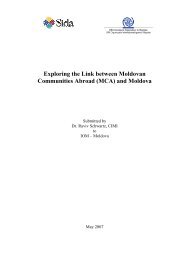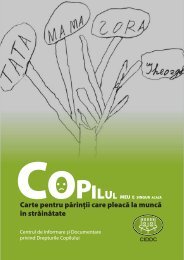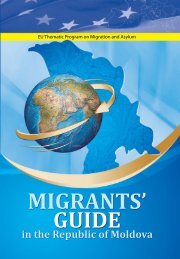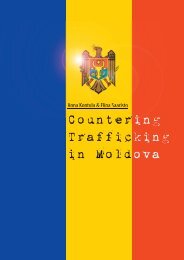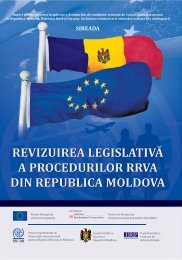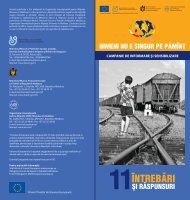Trafficking in Human Beings in Southeastern Europe - Iom
Trafficking in Human Beings in Southeastern Europe - Iom
Trafficking in Human Beings in Southeastern Europe - Iom
- No tags were found...
You also want an ePaper? Increase the reach of your titles
YUMPU automatically turns print PDFs into web optimized ePapers that Google loves.
<strong>Traffick<strong>in</strong>g</strong> <strong>in</strong> <strong>Human</strong> Be<strong>in</strong>gs<strong>in</strong> <strong>Southeastern</strong> <strong>Europe</strong>Summary andRecommendationsSummary andRecommendations1. Roles of Government, <strong>in</strong>ternationalorganisations and NGOsAlthough the majority of actions aga<strong>in</strong>st traffick<strong>in</strong>g were undertaken after theyear 2000, some anti-traffick<strong>in</strong>g <strong>in</strong>itiatives <strong>in</strong> SEE started before, as early as<strong>in</strong> 1997. The majority of the early activities were <strong>in</strong>itiated by local NGOs <strong>in</strong>response to the situation on the ground – the need to support traffickedwomen and the need to raise awareness. A more structured approach to traffick<strong>in</strong>g<strong>in</strong> the region, <strong>in</strong>volv<strong>in</strong>g all relevant actors as well as foster<strong>in</strong>g regionaland <strong>in</strong>ternational co-operation and <strong>in</strong>formation exchange, started after thegovernments of SEE signed the Palermo Protocol and the SPTTF M<strong>in</strong>isterialDeclaration <strong>in</strong> December 2000.1.1. Role of Governments: summary and recommendationsS<strong>in</strong>ce the end of 2000, there has been a major change <strong>in</strong> attitude and <strong>in</strong> thelevel of the government <strong>in</strong>volvement <strong>in</strong> counter-traffick<strong>in</strong>g activities. Fromdeny<strong>in</strong>g the existence of traffick<strong>in</strong>g just couple of years ago, the governmentsare now giv<strong>in</strong>g priority to anti-traffick<strong>in</strong>g <strong>in</strong>itiatives and assign<strong>in</strong>g responsibilitiesat m<strong>in</strong>isterial level. The governments have also developed NPAs, whichallow a structured, comprehensive approach to the problem, and the <strong>in</strong>volvementof <strong>in</strong>ternational agencies and NGOs, as well as a will<strong>in</strong>gness to co-operateand exchange <strong>in</strong>formation at regional level.Although regional and national mechanisms to combat traffick<strong>in</strong>g have beendeveloped by the governments, the establishment of work<strong>in</strong>g structures is still<strong>in</strong> progress and the implementation of the NPAs has barely started. Therefore,at this po<strong>in</strong>t it has to be stated that although the governments <strong>in</strong> SEE havemade significant progress and have clearly expressed the political will to combattraffick<strong>in</strong>g, they are still not able to discharge their <strong>in</strong>ternational obligationswith respect to combat<strong>in</strong>g traffick<strong>in</strong>g <strong>in</strong> persons, especially women andchildren.The multitude of often ad hoc <strong>in</strong>itiatives and projects already be<strong>in</strong>g implementedon the ground by <strong>in</strong>ternational organisations and NGOs are not partof the NPA frameworks s<strong>in</strong>ce these activities were not planned or implemented<strong>in</strong> co-operation or co-ord<strong>in</strong>ation with the government. This partly reflects thelack of attention and the <strong>in</strong>action on the part of the governments for manyyears, which has resulted <strong>in</strong> <strong>in</strong>ternational organisations and NGOs tak<strong>in</strong>g thelead <strong>in</strong> anti-traffick<strong>in</strong>g actions.1.1.1. National Plans of ActionGenerally speak<strong>in</strong>g, there are two types of NPA. Firstly, there are NPAs thatare based on, or even duplicate, the model NPA provided by SPTTF. Theseplans cover all areas of concern, <strong>in</strong>clud<strong>in</strong>g prevention, rais<strong>in</strong>g of awareness,victim protection, return and re<strong>in</strong>tegration, legal reform, law enforcement,tra<strong>in</strong><strong>in</strong>g, regional co-operation and exchange. Such NPAs create a frameworkfor counter-traffick<strong>in</strong>g activities, but are general and often do not stipulate153



